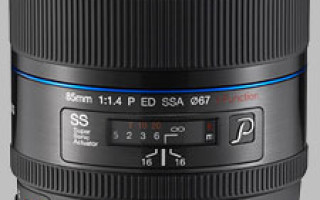Samsung NX 85mm f/1.4 ED SSA lens review
Samsung NX 85mm f/1.4 ED SSA lens review
Samsung was one of the first to bring mirrorless cameras to the market. Since then, the release of new lenses has continued, which are very interesting for their characteristics. Today's review will feature the Samsung NX 85mm f/1.4 ED SSA lens. This is a classic portraiture. In terms of some characteristics, it is similar to the 125/2.0 lens.
NX 85mm f/1.4 ED SSA Specifications
- Bayonet: NX Samsung.
- Focal length: fixed - 85 mm.
- Aperture: f/1.4.
- Smallest aperture: f/22.
- Number and type of petals: 10, rounded.
- Lenses: 10 lenses, 8 groups.
- Focus motor: ultrasonic - SSA (SuperSonic Actuator).
- Focus scale: yes.
- Manual focus adjustment: yes.
- Shortest focusing distance: 0.82 m.
- Maximum scale: 0.13x.
- Dimensions and weight: 92 mm x 79 mm, 714 grams.
Appearance and design
The Samsung NX 85/1.4 is a pretty solid lens. Its body is made of metal. The focusing and i-Function rings are rubberized and smooth. The front lens diameter is 67 mm. The build quality of the lens is excellent overall. It is worth paying attention to the fact that the NX85/1.4 has a distance scale, a focus mode switch (automatic and manual), and an i-Function button.
What makes the biggest impression is the size of the lens. This device looks quite funny on the compact, small cameras in the NX line.
When testing the lens with the NX200, it didn't perform well. The device was constantly leaning forward. Framing with this lens is difficult due to the lack of stabilization. we can assume that it will behave much better on larger cameras. For example, the NX 20 would look much better with this “Glass”.
Autofocus
The Samsung NX 85/1.4 lens is equipped with an ultrasonic motor for focusing. Focus adjustment occurs completely silently, but it happens too slowly. This is due to the large mass of the focusing mechanism and the small depth of field, which in turn requires high precision when focusing. Focus adjustment can be done manually without switching to manual mode.
With the NX200, the NX 85/1.4 lens did not show the best focusing accuracy.
Image quality
The NX 85/1.4 creates very good and high-quality images. The image quality is excellent. The lens has excellent resolution even with an open aperture, but the contrast is greatly reduced. This is due to spherical aberration. The lens can be called really sharp from an aperture of f/2. In general, this applies more to high-aperture optics.
A nice feature of the NX 85/1.4 lens is the soft nature of the out-of-focus zones. Smooth background blur is achieved thanks to rounded aperture blades.
Final conclusions
Undoubtedly, the NX 85/1.4 ED SSA lens is the leader in the Samsung NX optics line. High-quality assembly and materials, high resolution and soft blur are the qualities with which it clearly stands out among its competitors.
Also, a nice nuance of the lens is its price. The retail price of the device is $840. This is half the price of similar optics from Nikon and Sony.
Perhaps the Samsung NX 85/1.4 ED SSA is a bait to attract users to Samsung technology, namely the NX line.
4 reasons to buy NX 85/1.4:
- excellent, high-quality resolution;
- nice background blur;
- silent autofocus + FTM support;
- excellent build quality and materials composition.
1 disadvantage of Samsung NX 85/1.4 ED SSA:
- low speed and low autofocus accuracy.
Samsung 85mm f/1.4 ED SSA NX
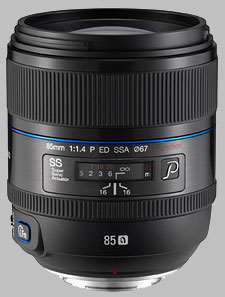
Lab Test Results
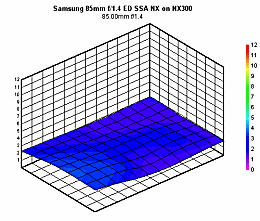
Chromatic Aberration
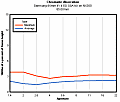
Vignetting
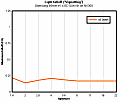
Geometric Distortion
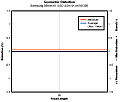
Your purchases support this site
Buy the Samsung 85mm f/1.4 ED SSA NX
SLRgear Review
May 22, 2014
by William Brawley
The Samsung 85mm ƒ/1.4 ED SSA lens is part of Samsung's premium, professional line of lenses and is the “crème de la crème” of portrait lenses for NX users. Despite being designed for a mirrorless camera, the 85mm ƒ/1.4 lens (130.9mm in 35mm eq.) is much larger and heavier than a typical mirrorless lens — more similar to a DSLR lens, in fact. Regardless of its physical properties, the Samsung 85mm ƒ/1.4 lens boasts some impressive specs, including Super Sonic Actuator (SSA) for fast, silent focusing; Extra Low Dispersion glass; and a 9-bladed rounded aperture diaphragm, that along with the wide ƒ/1.4 aperture, makes for creamy, smooth bokeh.
So, how does this professional portrait prime stack up? Read on below for our full battery of tests, handling notes and conclusion.
The Samsung 85mm ƒ/1.4 ED SSA ships with front and rear caps, lens hood and a pouch for around $849. You can buy this lens, or any other product, from one of our trusted affiliates and your purchase helps support this site! — Amazon; Adorama; B&H
Sharpness
As is often seen on ultra-fast lenses, wide-open sharpness can be a challenge, and such is the case here with the Samsung 85mm ƒ/1.4. Wide open, there is some obvious softness across the whole frame. A simple click on the aperture dial down to ƒ/2, however, and the lens sharpens up very quickly to an impressive degree. Stopping down to ƒ/2.8 or ƒ/4, and this lens displays excellent sharpness with barely any corner softness. Diffraction limiting softness is also quite minimal, with it only really having a minor effect at the smallest ƒ/22 aperture.
Looking at our test images, the softness at ƒ/1.4 is noticeable, unfortunately, but certain photographers might enjoy this softer, dreamier look. In real-world images, the softness at ƒ/1.4 is visible if you're pixel-peeping, but overall images look decent with an nice, razor-thin depth of field and smooth out of focus backgrounds. As mentioned though, if you want critically sharp portraits with this lens, it's best to stop down a bit.
Chromatic Aberration
Chromatic aberration is very well controlled on this Samsung lens, both in the corners and on average throughout the frame, and remains very low throughout the entire aperture range. Looking at our test chart images, CA in the corners at ƒ/1.4 is quite minimal, with only hints of purple-ish fringing on high-contrast edges, and at ƒ/8, CA is hardly visible at all.
Shading (“Vignetting”)
Like CA, vignetting on the Samsung 85mm ƒ/1.4 lens is very minimal as well, showing a maximum amount of light falloff at ƒ/1.4 just shy of 0.25EVs. Stopping down doesn't have much of an effect at reducing vignetting. However, it remains steadily under 0.25EVs all the way to ƒ/22.
Distortion
As you would hope from a professional-level portrait lens, the Samsung 85mm ƒ/1.4 lens displays impressively little distortion. Based on our tests, the average distortion is practically zero. In the far corners, though, we calculated just a hint of barrel distortion, but it's such a miniscule amount that it can be considered negligible.
Focusing Operation
As mentioned above, the Samsung 85mm lens uses an electronic Super Sonic Actuator (SSA) AF motor that's virtually silent and fast. However, it's not going to win any awards for its autofocusing speed, though is it nice and quiet. While the AF system is very snappy for short changes in focus distances, the lens takes over a full second to rack from minimum distance to infinity. Overall, the lens's AF performance is quick enough for most subjects, particularly with short changes in subject distance.
With manual focusing, there is an external switch on the side of the lens to enable full-time manual focus, however the SSA AF system allows for full-time MF override as well, so you can tweak focus manually even while AF is engaged. The focus ring has about 150 degrees of rotation for precise, accurate adjustments, and the nearly 1-inch wide, ribbed rubber ring is easy to grip and very smooth to rotate.
Macro
This lens is not designed for macro shooting due to its 82cm (32.3 in.) minimum focusing distance that provides only a 0.13x magnification.
Build Quality and Handling
The Samsung 85mm ƒ/1.4 ED SSA is a big, heavy lens, weighing in at over 1.5lbs and over 6 inches long if you count its deep lens hood, and its large diameter barrel is designed for 67mm filters. This NX-mount lens, for use with Samsung's APS-C mirrorless cameras, is a far cry from the small, lightweight lenses for other mirrorless systems, such as the Micro Four Thirds standard, for example.
Constructed out of an all-metal barrel with a smooth black finish and a metal lens mount, the Samsung 85mm has a substantial heft and a high quality feel. As mentioned earlier, this lens tips the scales at a little over 1.5lbs, so it's certainly not your everyday walk-around lens, though it's smaller and more portable than something like a Canon 85mm f/1.2L II. Inside the barrel, the optical layout consists of 10 elements in 8 groups, including one Extra Low Dispersion lens for better chromatic aberration control, which seems to have done its job well. The 9-bladed circular aperture diaphragm helps create smooth, pleasing background blur.
The large 7/8th-inch wide focus ring has a nice, smoothly rotating action to it, with about 150-degrees of rotation and hard stops at at minimum and infinity focus distances. The deeply ribbed rubberized coating makes it easy and comfortable to grip. The lens features a built-in focus distance window and a depth of field scale (though it only has DOF markings for ƒ/22).
Typically, prime lenses have a single ring around the barrel — the focus ring — but the Samsung 85mm includes a second thinner ring back toward the rear of the lens, called the i-Function ring. This multi-use ring, when activated by the “i-Fn” on the left side of the lens (above the AF/MF toggle switch), allows you to adjust all sorts of camera exposure and image quality settings. Simply press the i-Fn button to toggle through settings like ISO, exposure compensation and white balance presets or even effects and filters — depending on the camera model used — and then rotate the ring to adjust as desired. It's a very handy feature, especially when paired with sleeker cameras like the Samsung NX300 that do away with a front control dial — since there's extra space on the lens, you might as well utilize it!
Alternatives
The alternatives to Samsung's own NX lenses are fairly limited. However, another Korean optics company, Samyang, makes NX-mount lenses. Samyang also offers 85mm ƒ/1.4 lens, but in a manual-focus only style. Other than the lack of autofocus, this Samyang fast prime produces similarly sharp images with very low distortion. The Samyang also displays less CA wide-open, though at the smaller apertures, it's quite similar to the Samsung. There's also much less vignetting from ƒ/2 onwards on the Samyang. Obviously, the biggest downside to this lens is the lack of AF, but if you're primarily shooting portraits of still subjects, or shooting video, perhaps that's not an issue after all. It's also a heck of a lot cheaper at around US$300!
Conclusion
The Samsung 85mm ƒ/1.4 ED SSA is an impressive lens for those NX-camera owners wanting a high-performance, professional-class fast portrait prime that's also well built and solid. The lens produces super sharp images, though not tack sharp at ƒ/1.4 unfortunately — things are bit soft — however, stopping down just a little bit and sharpness ramps way up. The other optical qualities of this lens are top-notch: low CA, low vignetting and practically zero distortion. The addition of Samsung's i-Function ring for added camera controls is a very cool feature, especially on certain NX cameras that lack a lot of physical dials and controls.
The all-metal construction makes this lens very solid and well built. However, building an 85mm lens with a fast ƒ/1.4 aperture takes a lot of glass, making this a wide, heavy lens weighing in at over 1.5lbs. It's certainly not lightweight or compact, but a serious lens for serious photographers. The high price tag also clues you into its seriousness. All in all, despite the unfortunate lack of wide-open sharpness, the Samsung 85mm ƒ/1.4 ED SSA is a fantastic portrait lens for Samsung shooters.
Product Photos
Sample Photos
The VFA target should give you a good idea of sharpness in the center and corners, as well as some idea of the extent of barrel or pincushion distortion and chromatic aberration, while the Still Life subject may help in judging contrast and color. We shoot both images using the default JPEG settings and manual white balance of our test bodies, so the images should be quite consistent from lens to lens.
As appropriate, we shoot these with both full-frame and sub-frame bodies, at a range of focal lengths, and at both maximum aperture and ƒ/8. For the "VFA" target (the viewfinder accuracy target from Imaging Resource), we also provide sample crops from the center and upper-left corner of each shot, so you can quickly get a sense of relative sharpness, without having to download and inspect the full-res images. To avoid space limitations with the layout of our review pages, indexes to the test shots launch in separate windows.
Samsung 85mm f/1.4 ED SSA NX Lens Review
Gary Wolstenholme reviews the Samsung 85mm lens, with a fast f/1.4 maximum aperture and silent focusing motor.
This telephoto prime lens for Samsung NX mirrorless camera sports a fast f/1.4 maximum aperture and a silent focusing motor that allows manual focus adjustments to be applied at any time.
Samsung 85mm f/1.4 ED SSA NX Handling and features
Due to the fast f/1.4 maximum aperture, this lens is quite large when paired with a mirrorless camera, although it remains reasonably lightweight at around 450g, and so balances fairly well on the Samsung NX20 body used for testing.
Autofocus is very quick for a lens of this type, locking onto static subjects almost instantly with enough accuracy to make good use of the shallow depth of field created by the fast f/1.4 maximum aperture. The manual focusing ring has a smooth action and is well damped, which makes applying fine focus adjustments relatively straightforward. It can be grabbed at any time during autofocus and adjusted manually. Closest focus is 81cm, which is fairly typical for a lens of this type.
A 67mm filter thread is supplied, which does not rotate during focusing. This makes the lens ideal for use with graduated or polarizing filters. High quality plastics have been used for much of the lens' construction and the lens mount is metal, which helps to convey an overall impression of good build quality.

Samsung 85mm f/1.4 ED SSA NX Performance
At maximum aperture, sharpness across the frame is already good and stopping down the aperture improves clarity across the frame, reaching very good levels by f/2 and excellent levels by f/2.8. Peak sharpness across the frame is achieved between f/4 and f/8 where sharpness in the center of the frame is outstanding, and approaching that level towards the edges.
| 85mm | $1,000 average price |
|---|---|

Resolution@85mm
How to read our charts
The blue column represents readings from the center of the picture frame at the various apertures and the green is from the edges. Averaging them out gives the red weighted column.
The scale on the left side is an indication of actual image resolution. The taller the column, the better the lens performance. Simple.
For this review, the lens was tested on a Samsung NX20 using Imatest.
Chromatic aberrations are very well controlled, with extremely low levels recorded at wider apertures. This low level of CA increases as the aperture is stopped down, but still doesn't reach the point where fringing may be too much of an issue, even at f/16.

Chromatic aberration @ 85mm
How to read our charts
Chromatic aberration is the lens' inability to focus on the sensor or film all colors of visible light at the same point. Severe chromatic aberration gives a noticeable fringing or a halo effect around sharp edges within the picture. It can be cured in software.
Apochromatic lenses have special lens elements (aspheric, extra-low dispersion etc) to minimize the problem, hence they usually cost more.
For this review, the lens was tested on a Samsung NX20 using Imatest.
Falloff of illumination towards the corners is incredibly well controlled for a lens with such a bright maximum aperture. At f/1.4 the corners are only 0.524 stops darker than the image center and visually uniform illumination is achieved with the lens stopped down to f/2.
Very little distortion is present in images taken with this lens. Imatest could only detect 0.51% pincushion distortion. The distortion pattern is uniform across the frame, which should make applying any corrections in image editing software a straightforward affair.
Contrast is good with this lens although shooting results in a visible reduction. Light sources just outside the frame can cause flare quite easily if the supplied hood isn't used, so it is probably a good idea to leave it attached at all times.
Samsung NX 85mm f/1.4 ED SSA Sample Photos
Value for Money
Samsung currently have a virtual monopoly on lenses for their NX system, as there are very few third party manufacturers producing lenses for their cameras. This lens is available for around £800, which certainly isn't cheap, but is quite reasonable for an 85mm lens with an f/1.4 maximum aperture.
Samyang currently produce a manual focus 85mm f/1.4 lens, which can be picked up for around £240, which is certainly a lot cheaper if you can live without the convenience of autofocus.
Samsung 85mm f/1.4 ED SSA NX Verdict
The sharpness of this lens delivers is excellent, and although the price may be high when compared to other Samsung NX lenses, it isn't when compared to 85mm f/1.4 lenses from the likes of Nikon or Sony.
Those looking for an excellent quality telephoto lens for their NX system camera, ideally suited for low light shooting and for creating shallow depth of field effects, as you may do when taking portraits, might not have that many options to choose from. However, this lens should certainly not be overlooked.
 |
| The Samsung 85mm f/1.4 lens has good sharpness at the maximum aperture, and is excellent when stopped down. |
Samsung 85mm f/1.4 ED SSA NX Pros
 Good sharpness at maximum aperture
Good sharpness at maximum aperture Excellent sharpness when stopped down
Excellent sharpness when stopped down Good build quality
Good build quality Low chromatic aberration
Low chromatic aberration
Samsung 85mm f/1.4 ED SSA NX Cons
 May be too bulky for the most compact NX system cameras
May be too bulky for the most compact NX system cameras Can be prone to flare
Can be prone to flare
Samsung NX300 review
Image quality - resolution

The resolution test was performed using a special test target. White balance according to the sample, exposure compensation +2/3EV. The pictures were taken in JPEG of maximum quality. Red frames indicate areas of the image that will be shown on an enlarged scale below.
Double-digit numbers on subsequent crops indicate the number of lines (x100) per full frame height. For example, 24 means 2400 lines across the entire frame height.
We usually mark with a pink stripe the theoretical maximum resolution that a camera can provide, taking into account the number of pixels in its matrix on the short (vertical) side. The Samsung NX300 uses a resolution matrix of 5472x3648 pixels, and this value is 3648.
Let's explain in a little more detail. Imagine a very primitive matrix, only 10x10 pixels in size. At best, such a matrix will be able to “resolve” ten lines - that is, form an image in which ten separate lines can be distinguished (both black stripes and white spaces between them are counted), but nothing more. Likewise, the theoretical maximum for the Samsung NX300 is 3648 lines. In practice, the value turns out to be less - the imperfection of the lens, matrix noise, and other factors contribute - so resolutions of the 3600+ level, and with them the pink stripe, are beyond the scope of our illustrations.
We took test images with three lenses: Samsung 18-55/3.5-5.6 OIS III (at focal lengths f=22 and f=48 mm), Samsung 45/1.8 2D/3D and Samsung 85/1.4 ED SSA at different aperture values.
Samsung 18-55/3.5-5.6 OIS III lens at f=22 mm (33 mm equivalent):

Fragments of the same images with horizontal raster lines:

Samsung 18-55/3.5-5.6 OIS III lens at f=48 mm (73 mm equivalent):

The same, horizontal lines:

Samsung 45/1.8 2D/3D lens in 2D mode (69 mm equivalent):


Finally, the Samsung 85/1.4 ED SSA (130 eq.mm):


We strive to present the results as clearly as possible, so we hope that you can clearly see everything from the illustrations - both the difference between the lenses and how sharpness depends on changing the aperture.
I would like to note the Samsung 85/1.4 ED SSA lens, which gives an excellent picture at a not so high cost. When using it as a portrait lens, the optimal area will probably be the F/4 aperture area, where it provides both maximum sharpness and fairly strong background blur. Opener apertures give a less sharp picture, but they can add volume to pictures, separating plans that for most lenses will simply be “infinity”. Compare two photos taken with apertures of F/5.6 and F/2. The distance to the ship, as far as I can judge from Yandex Maps, is about 100 meters. Click to download full 12 MB files.
 |
 |
| Av mode, ISO100, f=130 eq.mm, F/5.6, 1/500 | Av mode, ISO100, f=130 eq.mm, F/2.0, 1/2500 |
It’s a bit of a pity that the Samsung 85/1.4 ED SSA lens does not have optical stabilization; nevertheless, at 130 equivalent millimeters it would be desirable. Although, of course, this is partly compensated by the high aperture of the lens, and in sunny weather the shutter speeds will definitely be quite short.
Note that the focal length coefficient for the Samsung NX system is generally considered to be x1.5, so a focal length of 85 mm should correspond to the equivalent of 85x1.5 = 127.5 mm equivalent, however, in EXIF the camera writes exactly the value 130 mm equivalent, which we and use it. Based on this, a more accurate coefficient value is x1.53.
The following images, taken at ISO 100, 400, 1600, 6400 and 25600, show how increasing ISO affects a camera's resolution.
Samsung NX 85mm F1.4 ED SSA Lens Review

Having waited months since its availability in Singapore, I finally got a review unit together with the Samsung NX20 last week.

At 696g, it's huge and heavy compared to the lightweight NX body – even the heaviest NX11 weighs only 353g. With a minimum focal distance of 0.82m, you can't use it for close-up shots like my favorite 60mm f2.8 MACRO lens. Focusing speed is not very fast but silent. You can override auto-focus anytime by turning the focusing ring.
 |
| The 85mm lens is huge and heavy compared to the latest Samsung NX20. |
The lens is better in its overall build and optical performance compared to the Nikkor 85mm f1.8 AFD I owned. Less fringing at large aperture, less haze effect when shooting against light, and certainly much sharper. From the photos taken with it, many people liked the bokeh, ie the blurness of the out-of-focus background.


More photos of my friend here.
Another set of photos taken with another friend.


Check out the shallow depth of field from the below photos:


What you notice is that the lens focuses sharply at the tip of the eyelashes. The eye ball, despite a mere millimeter difference away, is clearly out of focus.
How would a normal kit lens like 18-55mm f3.5-5.6 compare with this 85mm f1.4 portrait lens? Here's your answer.

See the background blur? That's bokeh.

The NX 85mm f1.4 is the most expensive lens among the NX lens, but it is certainly worth it. A camera is useless if the lens does not help you capture the images you want. A slow lens (small aperture) will reduce shutter speed and potentially make your handheld images blur. The 85mm f1.4 is the brightest lens in the Samsung NX line-up. If you love to capture powerful portrait images, then this lens will give you the shooting edge.
Samsung 85mm f/1.4 ED SSA iF Review
Key Specifications
- Review Price: £620
In the days of 35mm film photography, many professionals chose either 85mm or 135mm lenses for portraiture. Samsung's new NX-mount 85mm prime has the same angle-of-view as a full-frame 130mm lens and it is therefore unsurprising that the company's launch press release described its 85mm as a premium portrait lens.
Sadly, an appropriate focal-length is not sufficient to justify such a grand claim: fortunately, Samsungs new lens has much more to shout about than this alone. Most importantly, it offers an ultra-fast f/1.4 maximum aperture setting coupled with quick and quiet auto-focusing that allows full-time manual adjustments. It also looks and feels very solid, immediately inspiring confidence in its handling and durability.
The broad manual-focusing ring is located towards the front of the lens and offers just the right amount of resistance across its approximately 100-degree throw. Manual focusing can be applied in AF mode and activates a magnified view to make critical adjustments easier to apply. There is also a purely-manual focusing mode that is most likely to be used when photographing static subjects under difficult conditions.
To the rear of the focusing ring is a focused-distance window, complete with depth-of-field markings for f/22, behind which sits Samsung's incredibly useful i-Function collar. An i-Function activation button and a focusing-mode selector complete the lens controls. The obvious omission is any form of image stabilization technology.
As well as a protective pouch, Samsung has included a generous hood with the lens but its surface finish is so slippery that there is a real danger of the lens being dropped if grasped by the hood. This is equally important whether the hood is fitted for use or reversed over the lens for storage, in which case it hides the entire barrel except for the two buttons at the very rear. In short, the lens hood is both a liability and an inconvenience so might usefully be put to one side.
Technical testing produced a very impressive MTF curve that remained above the critical 0.25 cycles-per-pixel level right across the aperture range save for the final one-third of an F-stop. Peak resolution occurs at f/4, achieving a remarkable 0.4 cycles-per-pixel. There was only the faintest hint of chromatic aberration on the high-contrast test target and no signs in any of the real-world photographs, which exhibited excellent visual sharpness. Taken together, these results justify a maximum 20/20 score for image quality.
The sheer size of Samsung's 85mm f/1.4 prime means it dwarfed the NX200 body used for this review: there is also a potential issue when using a tripod as the lens barrel extends below the camera's base-plate, making it difficult (but not impossible ) to seat a large tripod plate squarely.
There is also a case for saying that a lens of this size and mass is better suited to use with a viewfinder body (such as the Samsung NX11) rather than the NX200 used here.
Sample images



Verdict
The slippery lens hood is annoying and the lack of image stabilization is an omission that some users may resent but this is an excellent lens in its own right and truly is, as Samsung claims, a premium portrait lens that is worth of very serious consideration.
Trusted Score
Unlike other sites, we thoroughly test every product we review. We use industry standard tests in order to compare features properly. We'll always tell you what we find. We never, ever accept money to review a product. Tell us what you think - send your emails to the Editor.
Samsung 85mm f/1.4 ED SSA NX



Description
The Samsung 85mm f/1.4 ED SSA NX is a one-of-a-kind compact telephoto lens with an F/1.4 aperture. The lens has a manual focus mode for more comfortable use and for those who like to experiment. You can set shutter speed, aperture and other parameters by simply turning the ring on the lens barrel. The Samsung 85mm f/1.4 ED SSA NX is designed for both amateurs and professionals. A convenient lens with i-Function support will meet all your requirements.
Lens, 2 protective caps (front, rear), lens hood.
The manufacturer may change the delivery package and country of production without prior notice, as a result of which at the time of sale of a particular product they may differ from those previously indicated.
Guarantee
Product warranty - 2 years. For warranty service questions, you can contact our store or the manufacturer's official service center.
Discounted products
This product is often viewed

Users also viewing

There are currently no reviews for this product. You can be the first.
There are no questions about this product at this time. You can be the first.

- Astrakhan
- Barnaul
- Bryansk
- Vladivostok
- Volgograd
- Voronezh
- Ekaterinburg
- Ivanovo
- Izhevsk
- Irkutsk
- Kazan
- Kaliningrad
- Kemerovo
- Kirov
- Krasnodar
- Krasnoyarsk
- Kursk
- Lipetsk
- Magnitogorsk
- Makhachkala
- Moscow
- Naberezhnye Chelny
- Nizhny Novgorod
- Novokuznetsk
- Novosibirsk
- Omsk
- Orenburg
- Penza
- Permian
- Rostov-on-Don
- Ryazan
- Samara
- Saint Petersburg
- Saratov
- Tolyatti
- Tomsk
- Tula
- Tyumen
- Ulan-Ude
- Ulyanovsk
- Ufa
- Khabarovsk
- Cheboksary
- Chelyabinsk
- Yaroslavl
- Vinnitsa
- Dnepropetrovsk
- Donetsk
- Zhytomyr
- Zaporozhye
- Kyiv
- Krivoy Rog
- Lugansk
- Lviv
- Makeevka
- Mariupol
- Nikolaev
- Odessa
- Poltava
- Sevastopol
- Simferopol
- Kharkiv
- Kherson
- Cherkasy
- Chernigov
- Aktobe
- Almaty
- Astana
- Karaganda
- Kostanay
- Pavlodar
- Taraz
- Uralsk
- Ust-Kamenogorsk
- Shymkent
You can buy the Samsung 85mm f/1.4 ED SSA NX in our online store by ordering delivery by courier at a time convenient for you.









